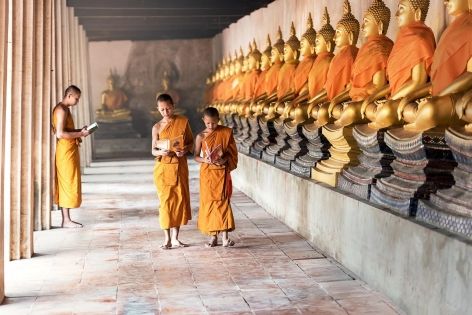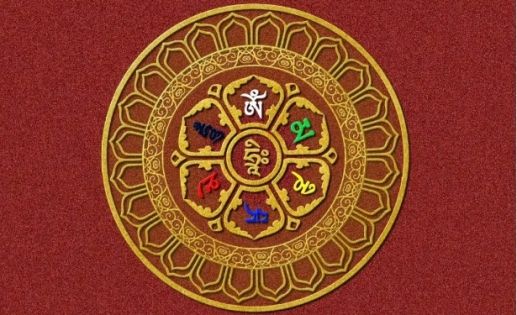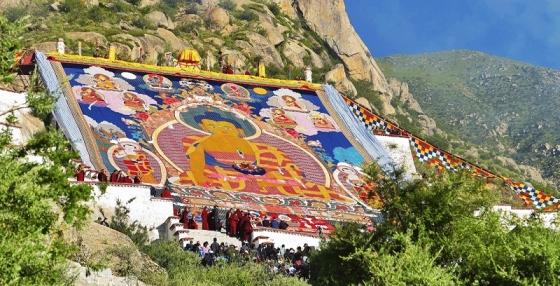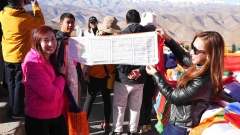Across Asia, Buddhism has taken many forms—each reflecting the unique culture and history of the region it spread to. Yet among them, Tibetan Buddhism stands out as one of the most complex, colorful, and spiritually rich traditions. Often described as “the soul of the Himalayas,” it combines profound philosophy with elaborate rituals, ancient art, and a deep sense of compassion.
In this article, China Dragon Travel takes you on a journey through the origins, beliefs, and practices that make Tibetan Buddhism distinct from other schools such as Theravada and Mahayana, revealing why this tradition continues to captivate travelers, scholars, and spiritual seekers worldwide.
The Origins: A Unique Blend of Indian and Indigenous Traditions
Tibetan Buddhism traces its roots to the 7th century, when Indian Buddhism was introduced to Tibet during the reign of King Songtsen Gampo. Later, during the 8th century, the Indian master Padmasambhava (Guru Rinpoche) brought Tantric teachings and established the foundation of what became Tibetan Buddhism.
What makes it truly unique, however, is that it didn’t simply copy Indian Buddhism. Instead, it merged with Tibet’s indigenous Bon religion, which was filled with shamanic rituals, spirit offerings, and deep reverence for nature. This fusion gave Tibetan Buddhism its distinctive mystical and ritualistic character—combining intellectual depth with symbolic, meditative, and magical practices.

The Vajrayana Path: The “Diamond Vehicle”
While most Buddhist traditions are divided into Theravada (“the Way of the Elders”) and Mahayana (“the Great Vehicle”), Tibetan Buddhism belongs to a third and more esoteric branch known as Vajrayana—the “Diamond Vehicle.”
Vajrayana teaches that enlightenment can be achieved within one lifetime through advanced methods such as mantra recitation, mandala visualization, deity yoga, and tantric meditation. These practices are considered “shortcuts” on the spiritual path—powerful but requiring great discipline and guidance from a qualified teacher or lama.
In contrast, Theravada Buddhism (common in Thailand, Myanmar, and Sri Lanka) focuses on personal liberation through monastic discipline and meditation, while Mahayana Buddhism (in China, Japan, and Korea) emphasizes compassion and the Bodhisattva ideal. Tibetan Buddhism includes all these teachings, but adds Vajrayana methods as the most direct and transformative route to enlightenment.
The Role of the Lama: Spiritual Teachers and Living Lineages
Another hallmark of Tibetan Buddhism is the deep respect for the lama, the spiritual teacher who transmits wisdom and blessings directly to the student. The lama is not merely a teacher but a living embodiment of enlightenment, guiding disciples through personal experience rather than theory.
The Dalai Lama and Panchen Lama are the most famous examples, but across Tibet, hundreds of lamas maintain spiritual lineages passed down for centuries. The belief in reincarnated lamas, known as Tulkus, such as the Karmapa or Sakya Trizin, ensures continuity of leadership and teaching through generations.
This system of reincarnation is unique to Tibetan Buddhism and reflects its conviction that compassion transcends death—enlightened beings consciously return to guide humanity again and again.
The Rich Symbolism: Mantras, Mandalas, and Sacred Art
Tibetan Buddhism is deeply visual and symbolic. Every color, image, and sound carries spiritual meaning.
-
Mantras, such as the famous “Om Mani Padme Hum”, are sacred syllables believed to embody the essence of compassion. Reciting them purifies the mind and connects one to divine energy.

-
Mandalas—intricate circular diagrams—represent the universe and serve as visual tools for meditation. The creation and dissolution of sand mandalas symbolize the impermanence of life.
-
Thangka paintings, butter sculptures, and prayer flags are not just art—they are expressions of devotion, carrying blessings to all beings when the wind blows or when viewed with reverence.
These artistic and symbolic forms make Tibetan Buddhism not only a religion but also an extraordinary cultural expression that fills monasteries and festivals with vibrant beauty.
Integration of Philosophy and Ritual
While Tibetan Buddhism is famous for its elaborate rituals, it is also one of the most philosophically sophisticated traditions. Tibetan monks study for decades in great monastic universities such as Drepung, Sera, and Ganden, mastering complex theories of emptiness (shunyata), dependent origination, and the nature of mind.

Ganden Monastery
What makes Tibetan practice special is how it integrates deep philosophy with everyday ritual. Meditation, chanting, and debate are all seen as ways to embody wisdom, not merely intellectual exercises.
During festivals like the Monlam Prayer Festival or Butter Lamp Festival, philosophy meets devotion—thousands of monks chant scriptures, debate Buddhist logic, and offer lights for world peace.
Compassion at the Core: The Bodhisattva Ideal
Though all forms of Buddhism value compassion, Tibetan Buddhism places it at the very center of spiritual life. Every practitioner aspires to become a Bodhisattva—someone who postpones personal nirvana to help all beings attain enlightenment first.
This ideal is beautifully captured in the mantra of Avalokiteshvara (Chenrezig), the Bodhisattva of Compassion, believed to be embodied by the Dalai Lama. His teachings of kindness, non-violence, and universal responsibility are practical reflections of this timeless ideal.
Even the most advanced tantric practices in Tibet begin with the cultivation of compassion and the vow to use all spiritual progress for the benefit of others.
Daily Life and Devotion: A Living Practice
Tibetan Buddhism is not confined to monasteries—it permeates every aspect of Tibetan life. Pilgrims walk for months, performing full-body prostrations on their way to Lhasa, Mount Kailash, or Lake Manasarovar, accumulating merit with every step.

Prayer wheels spin along mountain paths, releasing blessings into the wind. Monks debate philosophy in monastery courtyards, while villagers hang colorful prayer flags over rivers and rooftops to spread positive energy.
This seamless blend of the spiritual and the everyday makes Tibetan Buddhism not just a faith, but a way of living in harmony with the universe.
Festivals and Pilgrimage: Buddhism in Celebration
Another distinctive feature of Tibetan Buddhism is its vibrant festival culture.
-
During the Saga Dawa Festival, Tibetans commemorate the birth, enlightenment, and death of Buddha with fasting, prayer, and acts of generosity.
-
The Shoton Festival in Lhasa features the unveiling of giant thangka paintings and Tibetan opera performances.

Shoton Festival
-
At the Butter Lamp Festival, thousands of butter lamps light up monasteries and temples, symbolizing wisdom dispelling ignorance.
These celebrations embody the Tibetan belief that joy and devotion are essential elements of the spiritual path.
The Global Influence of Tibetan Buddhism
In recent decades, Tibetan Buddhism has gained immense popularity worldwide. Its teachers, including His Holiness the 14th Dalai Lama, Lama Zopa Rinpoche, and Chögyam Trungpa Rinpoche, have shared its teachings across continents.
People are drawn not only to its wisdom but also to its emphasis on compassion, mindfulness, and the interconnection of all beings. Tibetan Buddhism’s holistic approach—uniting heart and mind, philosophy and art—resonates deeply with modern seekers searching for balance and meaning.
Experiencing Tibetan Buddhism Firsthand
To truly understand what makes Tibetan Buddhism unique, one must experience it where it thrives—in Tibet itself.
Visitors traveling with China Dragon Travel can explore iconic monasteries such as Jokhang Temple, Potala Palace, Tashilhunpo Monastery, and Sera Monastery, where ancient rituals and philosophical debates still take place.
Witnessing monks in saffron robes chant mantras under the clear Tibetan sky, or watching pilgrims prostrate on Barkhor Street, offers insight into a living tradition that has endured for over a thousand years.
Conclusion
Tibetan Buddhism stands apart from other Buddhist traditions not only for its esoteric teachings and colorful rituals but for its integration of wisdom and compassion, its reverence for teachers, and its profound vision of enlightenment as attainable for all.
It is a path where philosophy meets devotion, where meditation blends with art, and where spiritual growth is seen as service to all beings. Whether you approach it as a traveler, a scholar, or a seeker, Tibetan Buddhism offers a mirror to the deepest truths of human existence—and a reminder that peace begins within.












